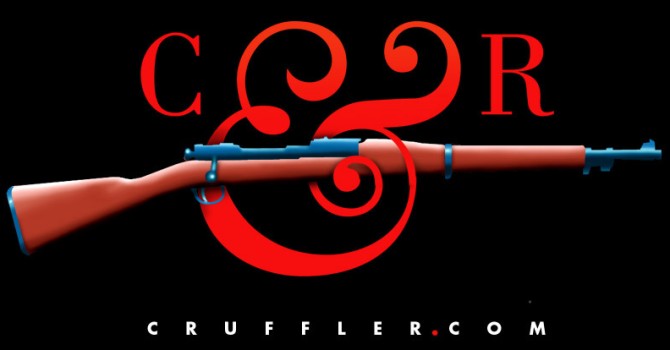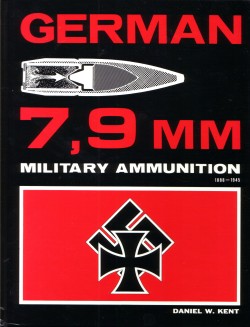
|
|
|
|
 |
| German
7,9mm Military Ammunition 1888-1945
by Daniel W. Kent Self published, 1990, hardcover 244 pages $25.00
|
|
An excellent example of a well addressed, narrowly defined subject matter can be seen in Daniel Kent's book, German 7,9mm Military Ammunition 1888-1945. There can be no doubt that the subject matter is of a seminal nature to the study of firearms history! The 7.9x57mm cartridge dates to the earliest days of the smokeless powder era and was in widespread use well into the age of the assault rifle. It is one of the few military cartridges to have undergone every major evolution in cartridge technology, absorbing each advance in projectile, propellant, primer and case technology as it unfolded (and being the proponent of some!). It is also one of the most prolific cartridges to see service, being adopted by more than forty nations, and even serving on both sides during the Second World War. Not the least of the cartridge's accomplishments are its progeny; the 7.9x57mm was directly responsible for the development of the US .30-06 cartridge, and with a little logical extension, the current 7.62mm NATO round. It is quite evident that Mr. Kent has chosen one of the broadest narrowly defined subjects within the realm of modern armament to write about.
Even a cursory glance at German 7,9mm Military Ammunition 1888-1945 is enough to indicate that Mr. Kent's efforts have been successful. The book is artfully written and skillfully organized. Political and technical history are blended in a seamless fashion that few authors manage to attain. At the same time, the book is richly supplied with captioned black and white photographs and line drawings that are well situated so as to both illustrate and amplify the text. Particularly useful is Mr. Kent's habit of supplying english translations for the german text found in many of the illustrations. It's a nice touch that many other authors would do well to emulate.
Organizationally, the book is divided
into three parts, each corresponding to a critical period in the cartridge's
development by the German military. Specifically, these are the First
World War, the Spanish Civil War, and the Second World War. Each
of these is further broken down into relevant technical divisions.
For example, the part covering the First World War includes sections on:
|
|
|
|
|
|
|
|
|
|
|
|
|
|
|
|
|
|
|
|
|
|
|
|
|
|
|
|
If a prioritization of the book's strengths was required, three features stand out. First among these is Mr. Kent's clear and lucid use of language to convey even the most obscure of facts and abstruse of ideas. The reader is drawn into Mr. Kent's circle as though invited. The feeling drawn from the text is one of sitting at the table of a learned pedagogue and being privileged to listen and learn. A pair of serve well as illustration:
(From the section on World War Two Armor Piercing Ammunition)
Velocity of the projectile is an important criterion if penetration is the desired objective. Or in other words, the higher the velocity, the greater the penetration. This ammunition has been repeatedly dubbed "Super Armor Piercing" and rightfully so. The superior penetration of the S.m.K.H. (Spitzgeschossmit Stahlkern - Gehartet - Pointed bullet with steel core - hardened) was accomplished by having a very heavy, yet small projectile driven at the maximum velocity safely obtainable with existing weapons and cartridge case. The core material was exceptional, in that tungsten carbide is much heavier and considerably harder than alloy steels, normally used in armor piercing bullets. This combination of high density, hardness and velocity permitted nearly a 100% increase in armor penetration over alloy steel cores.(From the Appendix on the The German Sniper and His Ammunition)The S.m.K.H. was reportedly introduced during 1936-1937 and designed for the Army for employment against light tanks. At this writing it is uncertain whether the S.m.K.H. was actually utilized in the MG17. The cartridge would have been reasonably compatible with high velocity v-ammunition as the charge weight for all practical purposes was the same. Although quite expensive to manufacture, the cartridge would have been a very effective round in the MG17 as the projectile had the potential of penetrating the heaviest armor on enemy aircraft and undoubtedly would have had a telling effect on the fine inner working of aircraft powerplants.
And now, gentlemen, we come to the most misunderstood, yet most intriguing of cartridges the sniper may have ever carried - the Nahpatrone. This is such an unusual item in that discovering how it was used, and how it functioned, has required considerable investigative effort. Through a stroke of good fortune, several relevant pieces of information have surfaced in recent years. The first item was a Polte factory drawing dated 23 February 1943, on the Nahpatrone. This drawing indicated that the cartridge with s.S. bullet was intended for the 98k rifle, and that the round was loaded with a 0.55 gram (8.4 grain) charge of #33 platzpatrone blank powder. An ultra rare Nahpatrone box label further confirmed that this type powder was employed.The second outstanding feature of the book is the proliferation and quality of illustration. Every page proudly sports relevant and amplifying line drawings (many of them done by the author himself) and photographs. These range from headstamps to Polish military cartridge schematics to cartridge drawings to primer composition diagrams to photographs of German military cartridge boxes. We can safely say that this is the single most profusely illustrated firearms book that we've had the pleasure to read. Moreover, we were struck by the quality of the illustrations.Armed with these few facts, an intriguing hypothesis began to evolve: Would combustion be so brief, and the cooling of gasses so rapid that muzzle blast would be reduced to a negligible state? Would a silencer really be needed, and would such a light charge of quick burning powder create a visible muzzle flash? Further consideration was given to the thought of blank powder behind a service bullet, a practice that would normally be frowned upon as extremely dangerous due to the fast burning properties common to blank powders. On the other hand the known charge level appeared to be conservative, and it was known that the cartridge produced subsonic velocities which in all probability would produce moderate pressures.
Finally, the book is provided with both an index and a bibliography that make it more than just a nicely executed esoteric work. These two elements transform Mr. Kent's book into a truly useful reference. Not only does it contain everything anyone could ever want to know about German military 7.9mm cartridges, but it does so in a such a way that the reader can find the right information at the right time.
CONCLUSION
Even a cursory look at the history
of military firearms in the twentieth century is sufficient to realize
the crucial role played by the 7.9x57mm cartridge. Knowledge of the
cartridge, the arms chambered for it, and its development is critical for
both the historian and the collector. German 7,9mm Military Ammunition
1888-1945 provides both an excellent overview and a detailed reference
to which no other volume can compare. Let's put it in much less uncertain
terms: If you own a single 7.9mm rifle (or machine gun for that matter),
have thought about owning one, or are merely interested in technical history,
you need this book. And at a selling price right around $25.00, how
can you resist?
German 7,9mm Military Ammunition is available from the John C. Denner Company. Click on the image to order:
 |